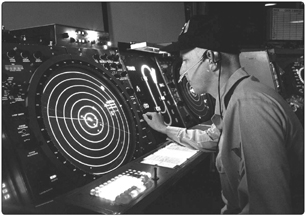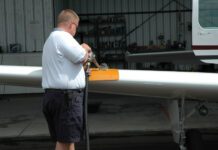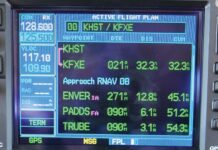
By Jeff Pardo
When I took the oral exam just prior to my Instrument check ride, the examiner asked me a difficult question: What would I do when there were low ceilings everywhere, and the temperature-dew point spread was shrinking? My answer was that I wouldnt take off in the first place with that kind of widespread moisture and cruddy weather. At first, I thought that probably sounded a bit evasive. However, it actually was the right answer for me, at that time, given what I was likely to be flying (single-engine airplanes, non-complex and not high-performance).
That was back in 1992, but actually, its still the right answer for me.In fact, I was a bit younger and sharper (and Ill be honest, probably a bit bolder as well), but the older I get, the wider that yellow streak gets-the one down the middle of my back. Still, all that said, weather forecasting isnt absolutely infallible, and good, otherwise-safe forecasts can and have gone bad. The sad truth is that things can get out of hand even for the best of us-vacuum failures come to mind as an obvious example. So let me turn the tables and ask you a similar question: What would you do (in flight this time) if everything was closing up all around you?
What They Are
It shouldnt require any preternatural leaps of inference, given the title of this article, but you probably already guessed where this is going. Among those things most worth knowing because of their value in allowing us to snatch victory from the jaws of defeat are seldom-used but critically important types of instrument approaches, and they involve…using radar.
There are two primary types, ASR and PAR: Airport Surveillance Radar and Precision Approach Radar. The third type, the no-gyro approach, can be had from either of the two others and tends to be spoken of as more of a generic type of service. All can be obtained from any properly equipped facility by any aircraft at the pilots request. Also, ATC may offer the radar approach option to any aircraft in distress or to expedite the flow of traffic (although the use of PAR for the latter would be surprising and quite unlikely).
Most instrument students know that the no-gyro approach is what to ask for, if ever their directional gyro becomes inoperative or unreliable. And most instrument pilots know that a no-gyro approach can be your ace in the hole if youre ever in IMC with widespread low ceilings and poor visibility, you find yourself faced with a vacuum pump (or perhaps your navigation radio) thats gone Tango Uniform, and you need to get down. During its execution, an actual human being issues verbal directives to take the place of your localizer needle.
Setting Up
Ill begin with the disclaimers and the obligatory finger-wagging. Even though the last word in ATC is control, it is still up to you, the pilot, to make sure that the approach minimums are lower than what weather is out there, and that you and the aircraft are up to the task. Also, lost communication procedures should be reviewed prior to any approach, to help you remember what ATC expects of you. (I realize that such unflustered methodical planning becomes difficult when you lose your vacuum pump, but I already warned about the finger-wagging.) Radar approach information appears in tabular form in the TPP booklets, listed by airport, and gives runway, minimum altitudes, ceiling and visibility criteria. I prefer the less-disjointed format used by Jeppesen-where everything is all in one place-but the FAA presentation is just as useful.
Unless youre using a radar approach for practice, or its the only procedure available to your destination, youre probably dealing with one or more system failures. In that event, the next but even more critical thing you should always remember to do is this: Cover up the dead displays! Whether it is the heading indicator, the artificial horizon or something else, its too easy to be misled, even subconsciously. If you dont happen to have the proverbial set of five-and-dime suction cup soap holders in your flight bag, cobble together something else, like a Post-It note.
The next thing (or while youre doing the first) would be to declare an emergency and ask for a no-gyro approach to the nearest place with better weather. If the fuel gremlin is also a factor, make it local. The good news with no-gyro approaches is that youll have one less thing to keep track of: namely, your headings. Instead, youll hear a lot of turn left or turn right (at the three degrees per second standard rate) and stop-turn requests. Altitude information is available as mentioned previously. Once theyve got you on the final approach course, youll be expected to perform all your turns at half standard rate.
Flying The ASR
Perhaps youve heard of airport surveillance radar, but do you really know what it is? This type of radar is fairly sophisticated and capable of more than just a squawk code and a by-your-leave with the local controller. In addition to the no-gyro variety, the approach called (logically enough) the ASR approach-or just surveillance approach for short-can be a feature of a fully functioning ASR site. Their purpose is to provide the pilot in need with assistance on his or her heading; range information can also be provided. This would be perfect in the scenario where someones DG still works, for instance, but their navigation radios dont. Note that there is no visual representation in this or any other radar approach. Also, theyre not authorized for an airport that is more than 20 miles from the radar facility being used, nor when Center Radar ARTS processing or CENRAP procedures are in use (which is because of the loss of accuracy inherent when ATC uses a mosaic of different sites).
During an ASR approach, ATC simply gives you progressive heading instructions to fly until youre lined up with the destination runway (or whats become your destination runway). Its really just radar vectors with a nervous tic and a faster beat. In fact, controllers sometimes use a variation of these for Tracon triage, when things get busy. During this type of approach, the controller also provides guidance in the form of headings, as well as telling you when to begin your descent to the minimum descent altitude. Theyll also give you the weather and missed approach instructions at the start of the approach, and they will advise you of the altitudes of any appropriate crossing fixes along the way.
I hasten to add here that vertical guidance is not possible; they can tell you how low you can be, but they wont tell you how low you are. As we shall see, this is the chief difference between ASR and PAR approaches.
You are also advised of your distance from the runway if you request it (or missed approach point) at one-mile intervals and, if you request it, recommended altitudes at each such point. Theyll keep feeding you headings and some altitudes right up until the point by which you hope to see the runway. Once at the missed approach point, you either land or go through it all over again (i.e., initiate a missed approach).
Due to the inherent lack of precision in the descent profile, landing minimums are higher than for any ILS to which you might compare it. But then again, what ILS comes with a dedicated and knowledgeable live human being coaching you to a landing?
Most ASR approaches tend to be somewhat flatter than an ILS; their optimal gradient is about one and two-thirds of a degree, but it can go up to twice that. This hand-holding also includes a decision on the part of ATC in deference to your safety; if the controller feels things are getting out of hand, he or she can issue the directive to execute a missed approach.
I might have made it sound easier than it is, because even if youre on top of your game flying instruments, you must realize that if you ever have to do this, it will be because of something that will likely have made you a bit preoccupied, distracted and upset beforehand. And if its been a while since youve been pushed to the edge of your envelope, then youll definitely be pretty frazzled.
So, the advice on this score is, if you ever get a chance to practice one of these, do so. Keep in mind that controllers need practice, too, so they might be more obliging than you would first think.
Flying The PAR
Despite the fact that during my primary training, I often held a death grip on the controls and I often felt far less than certain that I wasnt one step away from an embarrassing and unseemly end, in retrospect most of my own personal revelations occurred under fairly benign circumstances. Actually, all were situations in which, at least from the perspective of my redoubtable instructor, the safe outcome of a flight was never seriously in doubt.
Among these aerial adventures was that oddball DME arc approach into Martin State Airport in Maryland, as well as my introduction to the Warp Five effect of flying through snow at night, returning from New Jersey.
Then there was that time, back when a GA airplane could blithely do such a thing, when we flew over to Andrews AFB, Md., and into the welcoming arms of Precision Approach Radar. This is the one you may have heard the most about.
My Andrews AFB experience, of course, was before 9/11 and the Flight Restricted Zone around Washington, D.C. But, rest assured, if you have declared an emergency, and its not one of your own making, you shouldnt worry about getting shot down if you really, really need to be in that airspace. Probably.
If things are really going down the tubes, the PAR is what you should ask for. The odds are that there is one available at a military airfield within the fuel range of your aircraft. In fact, a PAR approach can get you down safely, assuming you dont go into auto-flail mode, when conditions are near zero-zero.
In a PAR approach, hand-holding is so unwavering and so precise that this isnt at all an exaggeration. In fact, if at any point you do not hear your controller for five or more seconds, it means an immediate missed approach; thats how carefully controlled these things are.
You will be constantly updated as to your position relative to on course, on glide path with a series of advisory terms which, while not quantified in terms of degrees or distance, nonetheless provide position and trend information. (Slightly left, slightly above or correcting slowly are the sorts of things you might hear.) They also tell you your range from touchdown every mile, and if things have really gotten scuzzy, they can tell you when youre over the runway threshold. Your worst problem might be safely taxiing back to the terminal area in pea soup fog.
Conclusion
I dont know why radar approaches dont receive more attention from the FAA or are more widely publicized by the popular aviation media. Perhaps, at least at the FAA, controllers dont like to hand them out for workload reasons. Thats a shame, because they can save lives. Be aware of them, and know where the emergency exits are, before things ever get too hot.
Also With This Article
“Radar Approach Primer”
“Finding A Radar Approach”
“Charting The Radar Approach”
-Jeff Pardo is a freelance writer and editor who holds a Commercial certificate for airplanes, helicopters and sailplanes.



